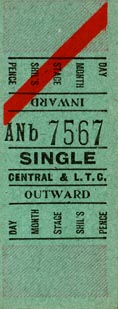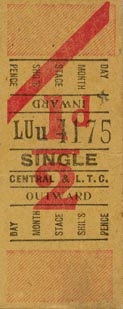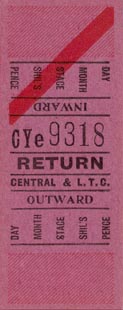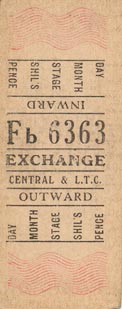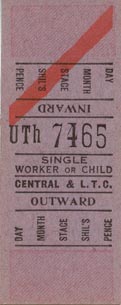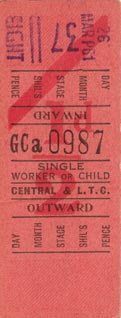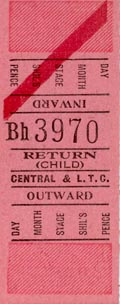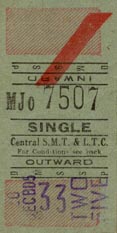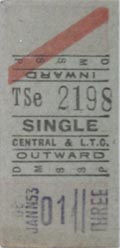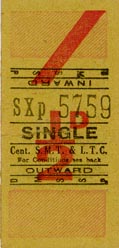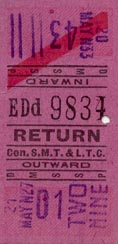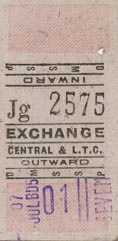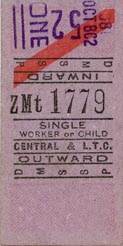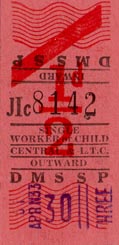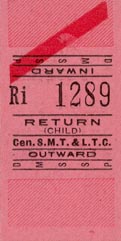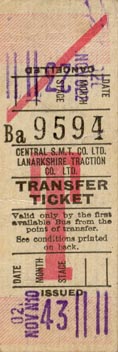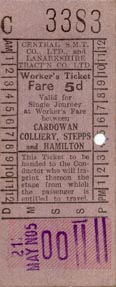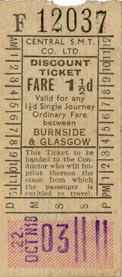Tickets : Original Setright Inserts
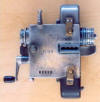 From its very early days right up to the late 1950s /early 1960s, Central SMT used the Setright Insert ticket machine. For those who don't remember it, there was no roll of paper tickets. As the name suggests, all tickets (including ordinary singles) were of the cardboard variety and were inserted into the front of the machine to be imprinted with the fare and other details. A picture of one of these machines (not a Central SMT example) appears on the left. (Click to enlarge)
From its very early days right up to the late 1950s /early 1960s, Central SMT used the Setright Insert ticket machine. For those who don't remember it, there was no roll of paper tickets. As the name suggests, all tickets (including ordinary singles) were of the cardboard variety and were inserted into the front of the machine to be imprinted with the fare and other details. A picture of one of these machines (not a Central SMT example) appears on the left. (Click to enlarge)
The Basics
The story begins with the following standard set. Throughout much of this Tickets section of the site, you can click a ticket image to view its reverse side. You then need to use your browser's Back button to return to the story :-
The first ticket is a normal single. The second in the series is explained by the fact that Setright Insert machines had no 1/2d steps. For any fare involving a halfpenny, the conductor would ring up the fare to the penny below, the balance being made up by the face value of the ticket. This type of ticket had a value whether imprinted or not and would be accounted for in the conductor's waybill. Incidentally, because they had an intrinsic value, halfpenny surcharge tickets could also serve as emergency tickets in the event of machine failure. This could rapidly get out of hand. A 1/- fare, for example, would require a wad of 24 tickets to be handed over in these admittedly unusual circumstances.
The third ticket in the group is a standard return. It would be imprinted with the return fare on one side during the initial journey and cancelled with a zero imprint on the opposite side during the return journey. The first three tickets feature a red stripe to help the conductor distinguish the outward and inward sides of the ticket. This may have been introduced during wartime, because of poor lighting during the blackouts. For an explanation of the difference between the outward and inward ends of the tickets, see below.
The final two tickets in this first group are Exchange tickets. On certain routes, Central SMT were willing to allow passengers of other operators to use their buses for the return journey. This applied to railway tickets and also, for example, to SMT tickets on the Edinburgh - Shotts - Glasgow or Edinburgh - Bellshill - Glasgow services. In these circumstances, the conductor would take the other operator's ticket from the passenger, then issue an exchange ticket for half the Central SMT return fare. This explains why a halfpenny surcharge version of the ticket had to be provided.
Workers and Children
For most member companies of the SMT group, the above represented the standard set of tickets. However Central SMT, in both Lanarkshire and Dunbartonshire, had its roots in tram replacement services. As trams traditionally had workers' tickets - and indeed the majority of passengers travelled at workers' rates - Central decided to introduce workers' tickets as well. When clear of Glasgow City Boundary, the worker's fare was normally half the adult fare. It was therefore logical to use the same tickets for children and workers, and for consistency a child's return was introduced. The standard Central SMT set therefore had the following additions :-
Downsizing!
The SMT group in the 1930s were different from many other users of Setright Inserts in that they used double-ended tickets, as shown above. As double-ended tickets were much less common in England, English tickets tended to be rather smaller. During the Second World War, due to paper shortages, SMT Group tickets were reduced to the standard English size, even though they remained double-ended. This resulted in the following :-
Transfer Tickets
The concept of changing from one bus to another on a through fare is not a new one. To allow this to happen, Central also had transfer tickets :-
To explain how transfer tickets worked, consider the following scenario and the pair of tickets on the right above. You want to make a return trip from Lesmahagow to Glasgow, but it is early on Sunday morning and first buses out of Lesmahagow are only going as far as Hamilton. In this situation, the conductor issued a return ticket for Glasgow in the usual fashion. It shows the fare paid (2/9) and the stage boarded (43). Because the bus is only going as far as Hamilton, the conductor also issued a transfer ticket, with a zero fare and stage 43 showing on the issued side. Having changed buses at Hamilton, the passenger handed both tickets to the conductor, who examined the return ticket and cancelled the transfer ticket with a zero fare and stage 23 (Hamilton) on the cancelled side. Later in the day, the return ticket was cancelled with a zero fare and stage 01 (Glasgow) for the return journey. Transfer tickets were also available in conjunction with single tickets.
Books of Tickets
Again, this is not a modern idea! Have a look at the following :-
Both of these tickets have been torn out of a book and carry pre-printed face-value fares. The first is for special miners' journeys between Hamilton and Cardowan Colliery, near Stepps. I have no idea whether miners had to buy these themselves, or whether they were provided through the employer. The second example is valid for any 'penny-ha'penny' journey between Burnside and Glasgow. The text on both tickets reads : 'This Ticket to be handed to the Conductor who will imprint thereon the stage from which the passenger is entitled to travel.' Notice that the imprinted fare is zero, as the ticket bears a face value and has already been paid for, i.e. no money changed hands on board the bus.
Machine variations
Early insert machines had only 20 settings altogether, running from zero (which was printed as a large X) to 1/7.
Pre-war machines had both shillings and pence dials. Both shillings and pence appeared on the ticket in upper-case letters, with zero printed as a double bar. The machine number appeared against the month.
Post-war machines printed the pence in lower case letters and the shillings in upper case. The machine number appeared next to the fare on the ticket.
Ticket Shields
Did you know that conductors once used plastic shields to protect rarely-used tickets on the ticket rack, and thereby help prevent mistakes? George Dawson tells an interesting story about these ...
During the Second World War, the Yorkshire-based firm Blackburn's was offered the chance to build sea-planes, even though it was located miles from the nearest coast. As it happened, Denny's of Dumbarton had also been thinking about getting into sea-planes, so the two companies got together and built a new factory on the Clyde. However, the traditional Clydeside skill-set was in iron & steel, not aluminium. So Blackburn's sent up some of their skilled staff from Yorkshire to run a training school, which was held in the nearby tram depot in Dumbarton. All of a sudden, aluminium ticket shields started to appear!
Inward and Outward
As previously mentioned, the SMT Group used double-ended tickets marked Outward and Inward as an additional security measure. The basic idea was that Central SMT and Western SMT services were deemed to flow outwards from Glasgow and inwards to Glasgow. Alexander's services flowed outwards from both Glasgow and Edinburgh through Stirling or Kirkcaldy to Perthshire and Fife, and inwards on journeys to Glasgow and Edinburgh. SMT services flowed outwards from Edinburgh to the Borders, Stirling and Glasgow, and inwards to Edinburgh.
A Central 2d single ticket marked with stage 23 would be for Hamilton Cross to Motherwell Cross (27), if on the outward end (out from Glasgow), or Hamilton Cross to Burnbank / Limetree, if on the inward end (in towards Glasgow). Or again, a ticket for 1/- stamped with stage 52 would be for Lanark to Biggar (Fountain), if on the outward end (out from Glasgow), or Lanark to Wishaw (East Cross), if on the inward end (in towards Glasgow).
Services which travelled across the main flow were usually deemed to travel outwards from the low stage numbers to higher stages. So, for example, services from Coatbridge (stage 02) or Airdrie (01) travelled southwards and outwards to the higher-numbered stages, such as Hamilton (18). When weekly tickets started to be issued on buses in October 1941, many stage numbers were altered so that any one place had the same stage number on all services, e.g. Hamilton stayed 23 (ex-Glasgow) and also became 23 (ex-Coatbridge & Airdrie).
The introduction of Setright Speed machines meant the end of 'out' and 'in' for single journeys, but returns still used the flow idea.
A further thought from George Dawson on 'out' and 'in' :-
I am in Buchanan St Bus Station, Glasgow and wish to travel to Wishaw. I spy and board an SMT bus, destination "Edinburgh, via Hamilton and Shotts". I pay 1/6 for my return ticket between Glasgow (stage 90) and Wishaw (stage 58). The ticket is stamped on the inward side, because it is "SMT inward" to Edinburgh.
I return to Glasgow on a Central SMT bus. The conductress keeps my SMT return ticket without stamping it. As a receipt, she gives me a CSMT Exchange ticket. It is stamped 9d and stage 33 on the inward side, to allow me to travel to Glasgow (01).
The flow system means that I have made two inward journeys on my return ticket!
Wartime Nostalgia



